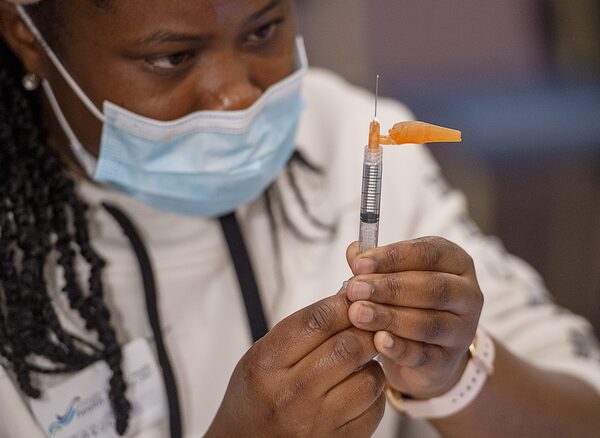
Carolyne Aremo, RN, prepares a Pfizer-BioNTech COVID-19 vaccine injection at a clinic in Upper Hammonds Plains, N.S., in April, 2021.Andrew Vaughan/The Canadian Press
On a quiet day in the intensive care unit of the Halifax Infirmary, registered nurse Joan Kearney described the new infection-control measures deployed against COVID-19 and the exhaustion of staff after nearly two years of the pandemic.
“I’m tired, just like everyone. It’s been a long journey,” Kearney said during a recent interview. “At the very beginning, the changes were coming daily as far as what we were doing and how we were doing it.”
The Infirmary is now in the midst of a lull, as hospitalizations from the most recent wave of the pandemic gradually decline. But staff say they’re expecting a new rise in cases, as most public health restrictions in the province are set to lift later this month.
“I don’t think it’s petering off,” Kearney said of the pandemic. “I think once things open up again, we will see another little blip, for sure.”
Provincial health officials announced last month that by March 21, restrictions such as gathering limits, social distancing and masking would end. Premier Tim Houston has said the province was ready to “make gradual changes” with “confidence.”
On Jan. 19, health officials reported 83 people in hospital who were admitted because of COVID-19, and by March 3 that number was nearly halved to 46 people.
Kearney, whose specialty is infection prevention and control, said she worked with the hospital’s many departments, from engineering to housekeeping, to outfit units to care for COVID-19 patients. The hospital installed new walls to protect staff and patients and planned out new walking pathways through the building to reduce the chances patients are exposed to the disease.
Dr. Sarah McMullen said the past two years have been somewhat “demoralizing” at times. The pandemic has inflicted an emotional toll on many within the hospital system, she said, especially those in intensive care, where restrictions prevented patients from being with loved ones during their final moments.
McMullen said now that the Omicron wave has subsided, it might be the best time to roll back restrictions.
“I think now is the time to do it with Omicron, which we know is highly contagious, but we also know it’s not virulent,” McMullen said. “There’s going to be ups and downs, but we know how to deal with those.”
Another doctor at the Infirmary, Christy Bussey, said that while residents across the province start to breathe a sigh of relief as restrictions lift, health-care workers continue to care for patients.
“There is no breath; there hasn’t been a breath since March of 2020, in fact,” Bussey said. “I don’t think we’re done with the pandemic. Rather, I don’t think COVID is done with us. I think COVID is going to be around for quite some time, just in a different form.”
That different form, she said, might look like the lingering symptoms suffered by some patients – the so-called “long haulers.” It might also come in the form of patients who have aggravated illnesses because their treatments have been put on hold.
Registered nurse Teri Jones said the backlog of surgeries put on hold because of the pandemic could become another “wave” that health-care workers will have to face.
“The acuity is still very high due to COVID and the (backlog) of all the delayed appointments and delayed surgeries … I think people have progressed to being a little bit sicker,” she said.
As restrictions gradually lift, Kearney said that within the hospital, the focus will always be on prevention and on adapting to future challenges.
“Hospital settings are very different from the community because our patient population is vulnerable,” she said. “In hospital settings, you can’t let your guard down … We have to always maintain due diligence.”